Listed 16 sub titles with search on: Main pages for wider area of: "AGION OROS Mountain HALKIDIKI" .
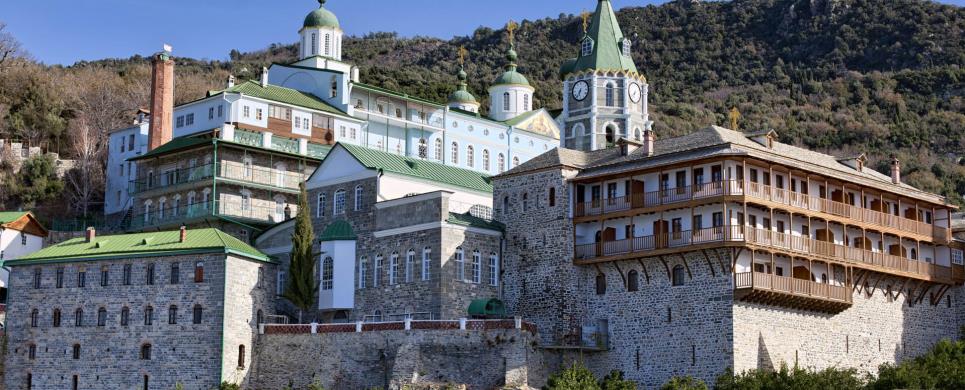
MONI AGIOU PANTELEIMONOS (Monastery) AGION OROS
Tel: +30 23770 23252, 23201
The monastery is built in a bay near the Xenophontos monastery, from
the side of Siggitikos and is dedicated to its namesake Saint. It gives the impression
of a small city with its many-stored buildings and the churches' tall cupolas.
The Katholicon is built in the early 19th c. and its frescoes are typical of the
russian art. The monastery has 15 chapels and 5 kellia, 2 of them at Karyes. The
monastery also owns the Chromitsa metochion, the Bogoroditsa (or the Carpenter's)
Skete, the Nea Thebais or Gournoskete and Paleomonastiro.
In the 13th c. the monastery is burnt and rebuilt with the financial
support of the emperor Andronicus II Paleologus and Serbian rulers. The monastery
knows alternatively periods of prosperity and great misery. The monks are Greek
and Russian, which outnumber the first after 1497. In the 18th c. the monastery
is again in greek hands, only to fall back to the Russians in 1875.
In the monastery there are many portable icons, heirlooms and liturgical
vestments. The library contains 1320 greek and 600 slavic manuscripts and over
20,000 greek and russian books.
The monastery in inhabited by a brotherhood of 40 monks.
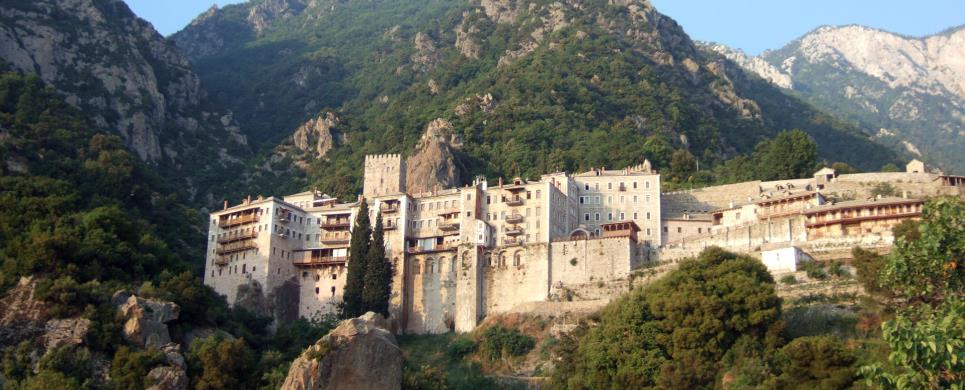
MONI AGIOU PAVLOU (Monastery) AGION OROS
Tel: +30 23770 23250, 23609, 23741-4, 23355
Fax: +30 23770 23355
It is situated in the west foot of Athos, 20 min from the sea and
is dedicated in the Presentation of Christ to the temple. The monastery was destroyed
many times by various causes, and its buildings belong to different periods. The
Katholicon was built shortly before the mid 10th c. The monastery has 12 chapels,
the most important of which is that of St George, with frescoes of the Cretan
School (1555). The monastery also possesses the Nea Skete and the Skete of St
Demetrius.
The monastery is mentioned for the first time, in the mid 10th c.,
mostly its founder Pavlos Xeropotaminos, and then in 1259. After the Catalan raids,
it is degraded into a kellion, only to become a monastery again in the 3rd quarter
of the 14th c. In the 15th c. it is financially supported by Serbians rulers and
after the fall of Byzantium, by rulers of eastern Europe.
Among the monastery's possessions, are counted portable icons, heirlooms,
holy relics and liturgical vessels.
The library contains 494 manuscripts and about 12,500 books.
The monastery is inhabited by a brotherhood of 30 monks.
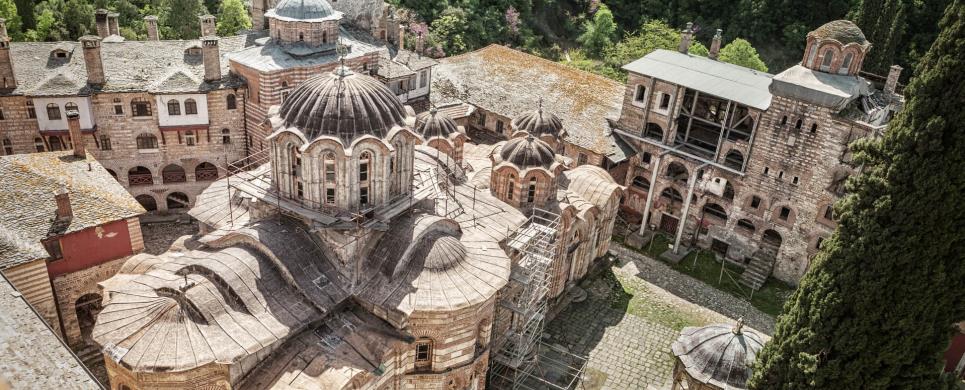
MONI CHELANDARIOU (Monastery) AGION OROS
Tel: +30 23770 23281, 23797, 23494, 23108
Fax: +30 23770 23494
The history of the monastery begins in the 10th century but, after
its ruin, the emperor Alexius III, in 1198 granted it to the Serbian rulers Stefan
Nemanja and his son Rastko, who became monks (Symeon and Sava respectively) who
proseeded to the construction of new buildings. During the 14th century, the monastery
reached its highest peak, accumulating riches and heirlooms from imperial as well
as private donnations.
One of the largest and richest in heirlooms monasteries of the Holy
Mountain, Chelandar is the main spiritual center of the Serbs from the 12th century
onwards. Besides the central church (Katholicon), honoured in the memory of the
Presentation of the Virgin, there are many chapels, the refectory and the aisles
with the monks΄ cells as well as the other auxiliary buildings (guest-house, library
and others).
The present monastic community preserves close relations with the
Serbian people as well as the Greek population of the Holy Mountain and its neighbouring
area.
Apart from the abundance of frescoes (St. George΄s Tower, Katholicon,
old and new Refectory etc), the monastery possesses one of the largest libraries
of Slavonic and Greek manuscripts, as well as a large number of portable icons
dated in the 12th century onwards.
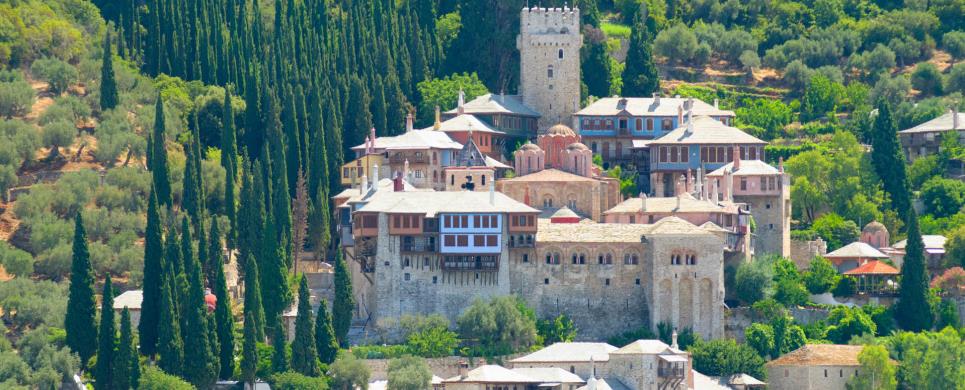
MONI DOCHIARIOU (Monastery) AGION OROS
Tel: +30 23770 23245
It is one of the most elegant and beautiful monasteries of the Holy Mountain, sited by the sea. One sees first the Refectoty (old and new) and ends at the uppermost
point on a high tower which dominates the place. The Katholikon, which is equally
high, has been built over the walls of the older church.
The monastery was founded during the second half of the 10th century;
its foundation is attributed to Euthymios, a pupil of Saint Athanasius of the
Great Lavra, who had the service of the "Docheion" (vessel), which gave the name
to the monastery. The Katholicon and the Refectory were built and decorated with
frescoes in the mid 16th century (1568). The wall-paintings of the Refectory are
dated in 1675 and in 1700 (the northern part).
Apart from the 16th century frescoes in the Katholicon, there are
also important frescoes of the 18th century in the exonarthex, which are excellent
copy of the 14th century from other monuments. Equally remarkable is also the
library of the monastery, where one can find, apart from the most important historic
monuments, abour 900 manuscripts.
The monastery is inhabited by a very active group of monks who take
care of its various needs -especially the hospitality to pilgrims and scholars.
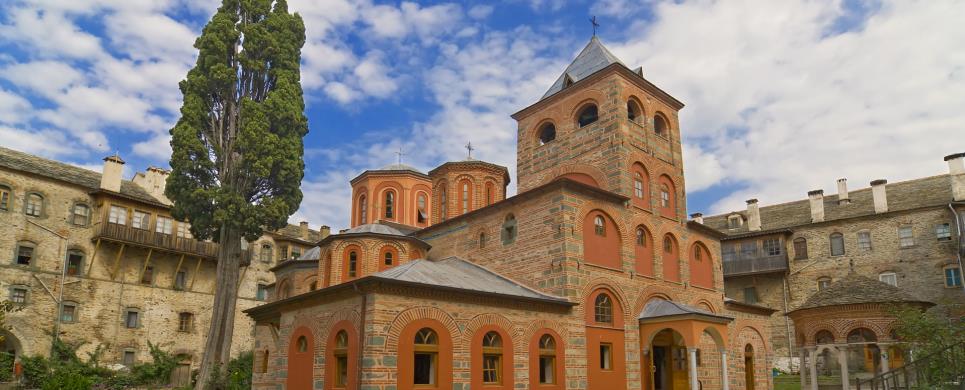
MONI FILOTHEOU (Monastery) AGION OROS
Tel: +30 23770 23256, 23674-9
Fax: +30 23770 23674
The monastery lies in a paltean, a little above the monastery of Karakallou
about 2.5 hrs from Karyes and is dedicated to the Annunciation of the Virgin.
The Katholicon is built shortly before the mid 18th c. and decorated with frescoes
after the mid 18th c. The monastery has eight chapels and 13 kellia, one of them
at Karyes.
The monastery was founded in the last quarter of the 10th c. but only
in the end of the 11th c. takes the form of a monastery. In the end of 13th and
14th c. the monastery receives financial aid by the emperors of Byzantium and
the Serbian rulers. After the fall of the empire, the monastery is financially
supported by the rulers of eastern Europe. In 1871, the monastery with the exception
of the Katholikon, the Refectory and the library, is burnt to the ground.
The monastery owns many heirlooms, holy relics and above all the miraculous
icon of the Virgin Glykophilousa. The library contains 250 manuscripts and many
books.
The monastery is inhabited by a brotherhood of 50 monks.
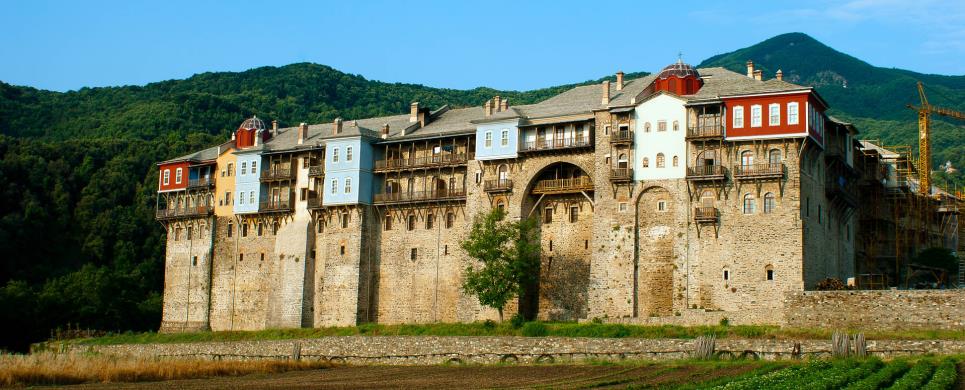
MONI IVIRON (Monastery) AGION OROS
Tel: +30 23770 23248, 23643-5, 23203
Fax: +30 23770 23248
Third in precedence among the twenty monasteries of the Holy Mountain,
the monastery was built in the end of the 10th century by the Georgian (Iberes)
monks Ioannis and Euthymius in the place where there was before the monastery
of Clement. The 16th century has been a period of prosperity for the monastery,
and, as result, it has been decorated with splendid painting works (the Katholicon
frescoes etc).
Built by the sea, the monastery is surrounded by four aisles, presenting
a rectangular shape. In the center, one sees the central church, founded in the
10th century, as the two historically important chapels, of Panaghia Portaitissa
and of John the Precursor. The largest part of the aisles has been rebuilt during
the 19th century.
A numerous monastic community is in charge of the restoration of the
ruined buildings surrounding the monastery and offers hospitality to scientists
from all the world, who wish to study the historic heirlooms of the monastery.
The monastery΄s feast is on August 15th - day of the dormition of
the Virgin - (August 28th in the New diary) and is celebrated with particular
splendour. Many pilgrims visit the monastery for the legendary miracles of the
Panaghia Portaitissa.
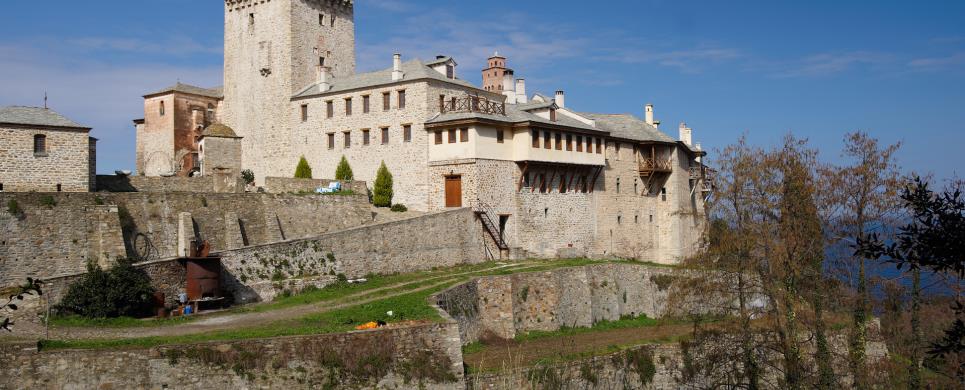
MONI KARAKALOU (Monastery) AGION OROS
Tel: +30 23770 23225, 23279
Fax: +30 23770 23746
The monastery is situated between the monasteries of Great Lavra and
Iviron, on a slope by the sea and is dedicated to St Peter and St Paul. Inside
the fortified enclosure, there is the Katholikon of athonite type, built in mid
16th c. and decorated with frescoes in the early 18th c. The monastery has 7 chapels,
4 Kellia in Karyes, and 14 Kellia in the forest to the S.W. of it.
The monastery is mentioned in documents of 1018 and 1087. In the 13th
c. the monastery is entirely ruined and rebuilt by the emperors Andronic II and
Ioannis V Paleologos. Afterwards the monastery is attacked by Latins and pirates.
In the 16th c. it is completely destroyed and rebuilt with the financial aid of
rulers of Moldavia and Vlachia.
In the monastery, there are many portable icons, holy heirlooms and
ecclesiastical vessels. The library contains 279 manuscripts and about 2,500 books.
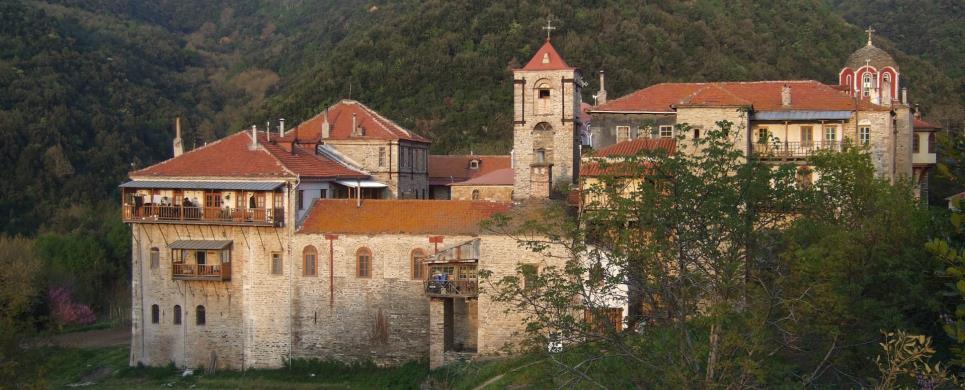
MONI KONSTAMONITOU (Monastery) AGION OROS
Tel: +30 23770 23228, 23278
The monastery is situated between the monasteries of Zografou and Dionysiou,
30 min from the sea, in the side of Siggitikos and is dedicated to St Stephen.
The Katholicon is built after the mid 19th c. following the athonite type, over
the ruins of the old Katholicon. The monastery has 9 chapels.
The first mention of the monastery is from the 11th c. In the early
14th c. it is destroyed. Afterwards, its borders are defined by imperial chrysoboula,
and it is financially supported by Serbian rulers. After the fall of the Empire,
the monastery knows alternatively periods of prosperity and great
Perhaps, the most outstanding of the monastery's heirlooms, are the
portable icons of St Stephen, of Virgin Hodegetria and of Virgin Antiphonetria.
There are also reliquaries, ecclesiastical vessels, chrysoboula and others. The
library contains 110 manuscripts and many books.
The monastery is inhabited by a brotherhood of 30 monks.
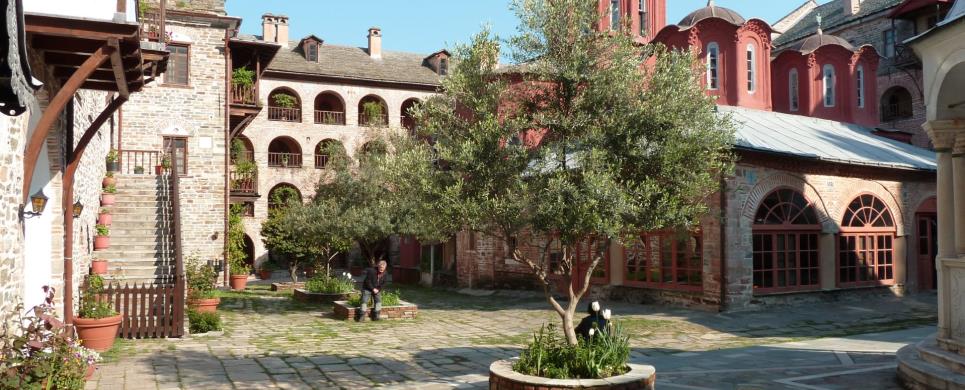
MONI KOUTLOUMOUSSIOU (Monastery) AGION OROS
Tel: +30 23770 23226
Fax: +30 23770 23731
The monastery buildings are set in a rectangular shape with a rather
vast courtyard, with the central church (Katholicon) in its center. The refectory
is presently built a new (1995), while the central church, built in the 16th century,
is covered with five domes and with a glass covered exonarthex.
The original monastery was built before the 12th century but in the
14th centutry, abbot Chariton of Imvros, receeded to the enlargement of the monastery;
during its lifetime vast destructions were caused either by fire or by fall of
rocks.
Apart from the Katholicon frescoes dated in the mid 16th century,
the monastery possesses more than 600 manuscipts, many of which are illuminated,
as well as imporant historic archive and a large number of old printed books.
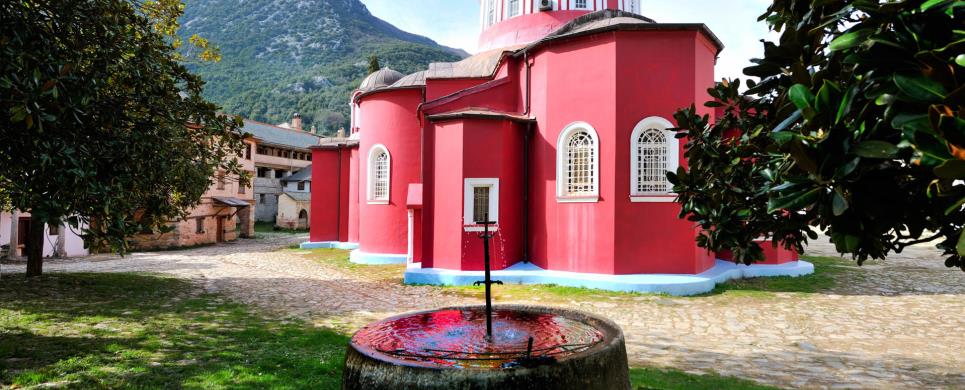
MONI MEGISTIS LAVRAS (Monastery) AGION OROS
Tel: +30 23770 23761, 23277
Fax: +30 23770 23762
It was built in 963 by St. Athanasius the Athonite, with the financial support of the emperors Nikephorus Phocas and Ioannis Tzimiskes. During the ten centuries of its existence, the monastery has always held the first place among the other monasteries of the Holy Mountain, partly because of its wealth, partly because of the heirlooms stored there (manuscripts, historic documents, chrysobulls, portable icons etc).
The monumental structure of the
monastery complex
is particularly noticed in its
large buildings.
The central church (the Katholicon)
with the two large chapels of the Forty Martyrs and of St. Nicholas, occupies the center of the monastery. Within the enclosure, there is also the refectory, the kitchen, the library etc. In the four aisles, which surround the monastery, are the monks cells, the guest-house,
chapels and others.
The monastery is inhabited by 50 monks whose daily occupations are
divided among their monastic duties (mass,prayers etc.) and the hospitality to
the many visitors from all the world.
The monastery remains open throughout the year from sunrise until sunset. During the winter months, it is extremely difficult to reach the monastery. The visitors who wish to study or take photographs of the monastery΄s works of art, must first contact the 10th Ephorate of Byzantine Antiquities as well as the monastery itself.
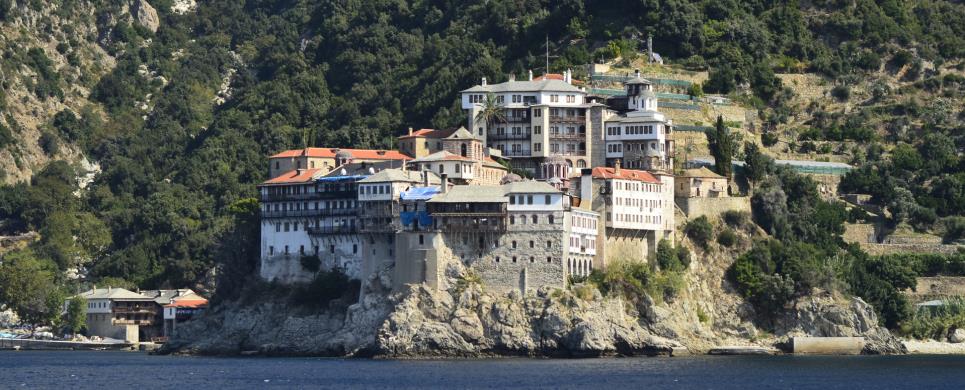
MONI OSSIOU GRIGORIOU (Monastery) AGION OROS
Tel: +30 23770 23218, 23669
Fax: +30 23770 23671
The monastery is built by the sea, in the S.W. side of the peninsula,
between the monasteries of Dionysiou and Simonopetra and is dedicated to St Nicholas.
The Katholicon is built and painted after the mid 18th c. The monastery has 10
chapels and 4 kellia in Karyes.
The monastery is built during the 14th c Afterwards, there is very
little information of it. The Russian pilgrims Barsky (18th c.) reports that the
monastery was restarted in 1500, is the smallest of the monasteries, and almost
all the heirlooms and the documents were lost in the fire of 1761. The monastery
is finally rebuilt with the financial aid of the princes of Moldavia and Valachia.
Inside the Katholicon are kept many heirlooms and portable icons,
the most outstanding of which are those of St Nicholas, of Virgin Galaktotropousa
and of Virgin Pantanassa.
In the library there are 297 manuscripts, about 4,000 books and many
documents.
The monastery is inhabited by a brotherhood of 70 monks.
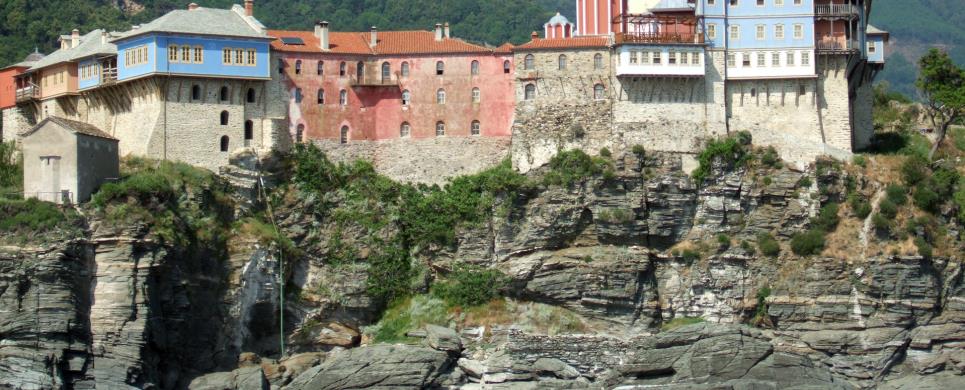
MONI PANTOKRATOROS (Monastery) AGION OROS
Tel: +30 23770 23253, 23685, 23880
Fax: +30 23770 23685
The monastery is built by the sea, in the N.E. side of the peninsula
and is dedicated to the Transfiguration of the Saviour. The Katholicon follows
the athonite type and has frescoes of the 14th c. that were painted over in 1845.
The monastery has 15 chapels, the most important of which is that of the Dormition
of Virgin. Among the Kellia of the monastery, the most important are of the Ravdouchou,
possibly of the 10th c. and the Dormition of the Virgin, named Axion Esti after
the namesake icon. The Skete of Prophet Elias belongs also to the monastery.
The monastery's founders were two byzantine officials, Alexios and
Ioannis, who in mid 14th c. with the support of the emperor Ioannis 5th Paleologus,
transformed their cell into a monastery. After the fall of the empire, the monastery
is financially supported by rulers of eastern Europe. Two destructive fires took
place in 1773 and recently in 1948.
The monastery possesses a large collection of portable icons, ecclesiastical
vessels and heirlooms, while in the library there are 350 manuscripts and over
3,500 books.
The monastery is inhabited by a brotherhood of 25 monks.
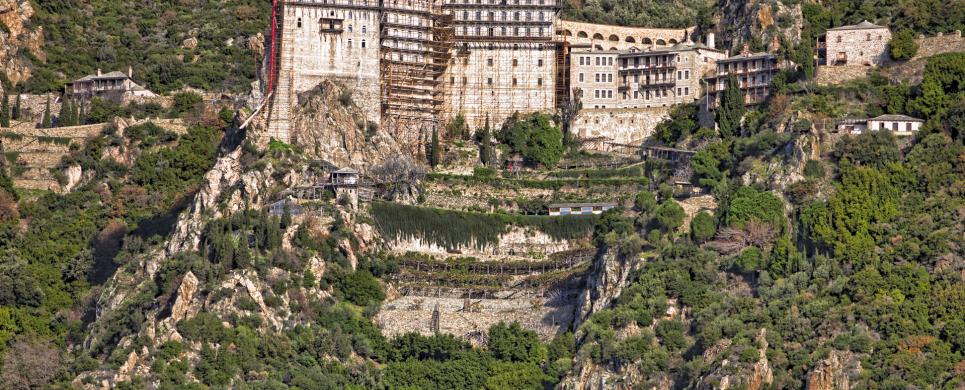
MONI SIMONOS PETRAS (Monastery) AGION OROS
Tel: +30 23770 23254
Fax: +30 23770 21014
The seven-stored monastery of Simonopetra is the most bold construction
of the peninsula, and is dedicated to the birth of Christ. The name comes from
the founder of the monastery, Hosios Simon, who lived in Athos in the mid 14th
c.The Katholicon was built after the last fire and has no frescoes. The monastery
has 15 chapels and 5 Kellia in Karyes.
At the end of 16th c. the monastery is burnt down, rebuilt and reburnt
in the beginning of the 17th c. This long period of decline is interrupted by
shorts periods of prosperity. At the end of the last century, the monastery is
one more time burnt, and rebuilt with funds from Russia.
Among the monastery's heirlooms, the most important is a piece of
Saviour's Cross, holy reliquaries and others. The library, after the last fire,
possesses only a few modern manuscripts and books.
The monastery is inhabited by a brotherhood of 60 monks.
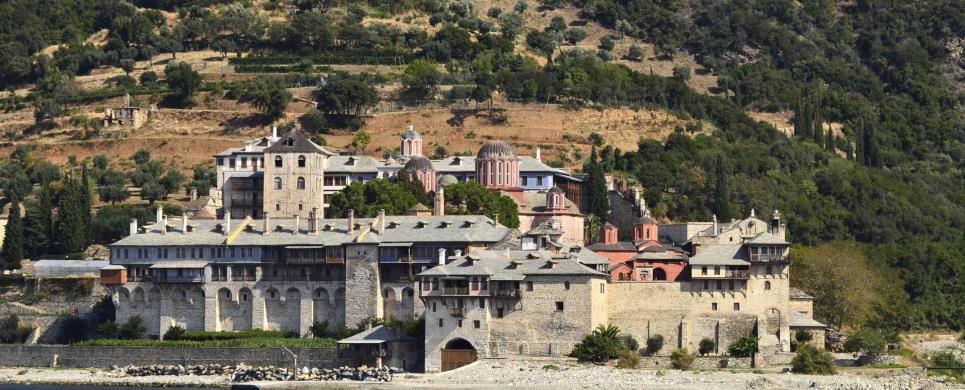
MONI XENOFONTOS (Monastery) AGION OROS
Tel: +30 23770 23249, 23633
Fax: +30 23770 23631
It is built by the sea, between the monasteries of Docheiariou
and St Panteleimonos,
and is dedicated to St George. The Katholicon is built in the early 18th c. and
has no frescoes. In the old Katholicon, there are remarkable frescoes of the Cretan
painter Antonius (1544) as well as the wooden-curved templum of the 17th c. The
monastery possesses 14 chapels, 8 of which are inside the monastery.
The monastery is mentioned for the first time in the last quarter
of the 11th c. Its period of prosperity is interrupted by the fall of Constantinople.
Afterwards, the monastery is alternatively destroyed and rebuilt with the financial
aid from the rulers of eastern Europe.
Among the heirlooms of the monastery, the most prized are the two
mosaic icons with the Transfiguration of Christ, ecclesiastical vessels and others.
In the library there are 300 manuscripts, various documents and over 4,000 books.
The monastery is inhabited by a brotherhood of 35 monks.
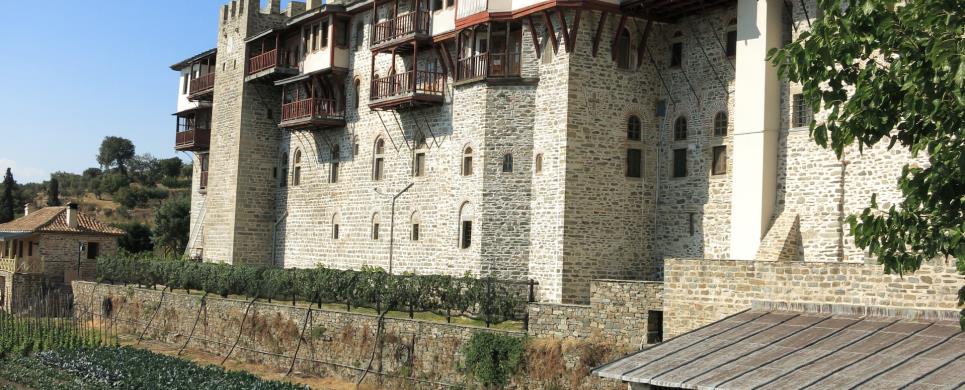
MONI XIROPOTAMOU (Monastery) AGION OROS
Tel: +30 23770 23251, 23733
Fax: +30 23770 23733
The monastery is in the middle of the athonite peninsula, on the way
from Daphne to Karyes and is dedicated to the 40 Martyrs. The Katholicon was built
in 1761 by the monk Caesarius Daponte and decorated with frescoes in 1783. The
monastery has several chapels and a few kellia.
The monastery was founded in the end of 10th c., possibly by the monk
Pavlos Xeropotaminos, and prospered till the Frankish conquest, when it is attacked
and sacked by pirates. In the late Byzantine period it is financially supported
by the Paleologan dynasty as well as Serbian rulers. After the fall of Byzantium,
the turkish raids, and two destructive fires in 1507 and 1609, cause serious damages
to the monastery.
The monastery owns a rich collection of heirlooms, the most outstanding
of which, is the largest in the world piece of the Christ's Cross, as well as
a small round steatite icon, known as the Pulcheria Disk.
The library contains about 400 manuscripts and 4,000 books.
The monastery is inhabited by a brotherhood of 30 monks.
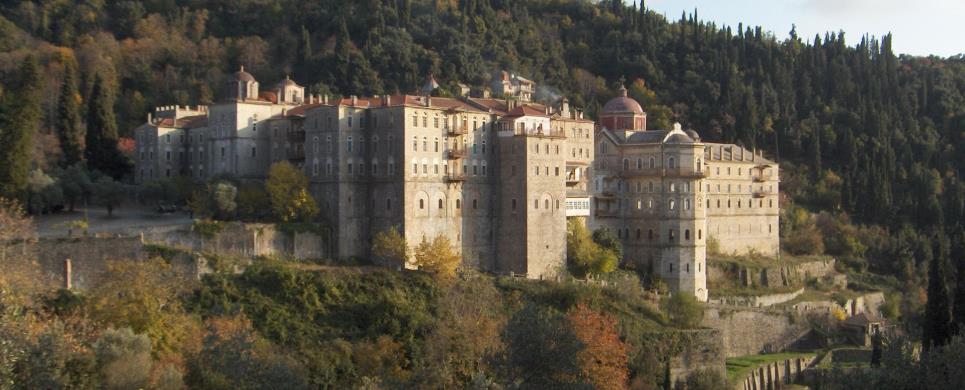
MONI ZOGRAFOU (Monastery) AGION OROS
Tel: +30 23770 23273, 23247
The monastery is situated on a slope of the S.W. part of the peninsula
and is dedicated to St George. The Katholicon was built in the beginning of the
last century and follows the athonite type. The monastery has eight chapels inside
and eight chapels outside of it. The monastery also owns two workshops in Karyes
and the Kelliou of Transfiguration.
The monastery was founded, according to tradition, in the 10th c.
by three brothers, Moses, Aaron and Ioannis from Achris. In the Late Byzantine
period, the monastery is destroyed by Catalan pirates and rebuilt with the financial
support of the Paleologan dynasty, as well as that of rulers of eastern Europe.
Initially, the monastery was inhabited by Bulgarians, Greeks and Serbs. Since
1845 there are only Bulgarian monks.
Besides two miraculous icons of St George and other two of the Virgin
of the Akathistos and the Virgin Epakouousa, the monastery owns and other heirlooms
and ecclesiastical vessels.
The library contains 126 greek and 388 slavic manuscripts, and over
8,000 books.
Receive our daily Newsletter with all the latest updates on the Greek Travel industry.
Subscribe now!